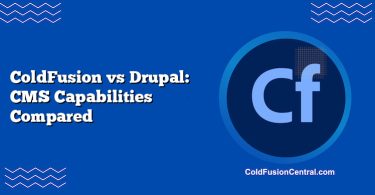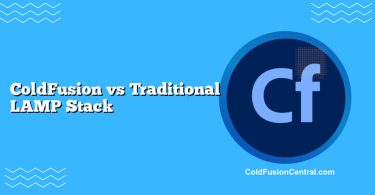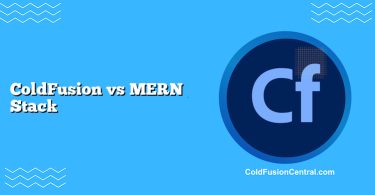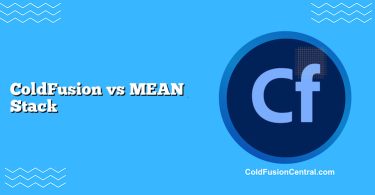Definitions at a Glance
What is ColdFusion (CFML)?
ColdFusion is a rapid application development platform and runtime for building server-side web applications and APIs using the CFML language. It’s available as Adobe ColdFusion (commercial) and Lucee (open-source). ColdFusion offers a high-level, batteries-included stack with built-in features for database access, email, PDF manipulation, scheduling, and native support for exposing and consuming both REST and SOAP services.
What is a REST API?
REST (Representational State Transfer) is an architectural style for building web services that use standard HTTP methods (GET, POST, PUT, DELETE) and representations such as JSON or XML. REST emphasizes statelessness, cacheability, and uniform interfaces, making it lightweight and broadly interoperable across web and mobile clients.
What is a SOAP API?
SOAP (Simple Object Access Protocol) is a protocol-based approach for web services relying on XML envelopes, WSDL (service description), and optional WS-* standards for security, transactions, and reliable messaging. SOAP is formal, strongly typed, and often used in enterprise systems where strict contracts and advanced security policies are required.
Overview and Positioning
Where Each Fits in the Stack
- ColdFusion: A server-side platform and language (CFML) that can implement business logic and expose APIs. You can build both RESTful endpoints and SOAP services with ColdFusion.
- REST: An API design style that can be implemented by many platforms (including ColdFusion, Node.js, .NET, Java Spring, Python/Django/Flask, Go, etc.).
- SOAP: A protocol for web services often backed by enterprise middleware (e.g., Java EE, .NET/WCF). It can also be served or consumed by ColdFusion.
The key distinction: ColdFusion is an application platform; REST and SOAP are API styles/protocols. Choosing between REST or SOAP is about the API contract; choosing ColdFusion is about the implementation stack powering your API.
Typical Toolchains and Supported Platforms
- ColdFusion platforms:
- Adobe ColdFusion: Windows, Linux; commercial license; rich admin and enterprise features.
- Lucee: Windows, Linux; open-source CFML engine; community-driven extensions.
- REST: Implementable on any platform supporting HTTP (virtually all platforms).
- SOAP: Common in .NET (WCF), Java (JAX-WS), and legacy enterprise ESBs; interoperable across languages via WSDL.
Language and syntax note for ColdFusion:
- CFML supports both tag-based and script-based syntax.
- Data formats: native JSON handling for REST; XML utilities for SOAP integration.
Key Features
ColdFusion Highlights
- Rapid development with CFML and built-in libraries (database, caching, scheduling, PDF).
- Native support for REST mappings and SOAP via WSDL.
- Enterprise features: task schedulers, ORM (Hibernate), secure profile settings, monitoring tools.
- Easy integration with databases (cfquery), mail, file operations, and external APIs.
REST Highlights
- Lightweight, human-friendly, JSON-first.
- Stateless by design; ideal for horizontal scaling and CDN caching.
- Broad client support (browsers, mobile apps, IoT).
- Flexible versioning approaches and discoverability via OpenAPI/Swagger.
SOAP Highlights
- Strongly typed contracts via WSDL and XSD.
- Advanced security (WS-Security), transactions, and reliable messaging.
- Formal error handling (faults) and strict schema validation.
- Preferred in regulated or legacy enterprise environments.
Performance
Latency and Message Size
- REST generally wins on wire efficiency using compact JSON over HTTP/1.1 or HTTP/2.
- SOAP messages are XML-heavy, increasing payload size and parse time.
- ColdFusion performance depends on how you build it: efficient CFML, caching strategies, and server tuning can deliver fast REST endpoints; SOAP services will inherit XML parsing overhead.
Caching and Statelessness
- REST’s stateless nature and cache-friendly GET requests enable strong performance behind CDNs or reverse proxies.
- SOAP can be cached but is less natural for web caches due to POST-heavy interactions and XML envelopes.
Binary Payloads and Streaming
- REST works well with binary uploads/downloads via HTTP; supports range requests and streaming with proper headers.
- SOAP can handle attachments (MTOM), but implementations are more complex and often slower.
Scalability
Horizontal vs. Vertical Scaling
- REST: Highly amenable to horizontal scaling and microservices. Stateless services scale linearly.
- SOAP: Can scale, but contract rigidity and stateful patterns in some enterprise deployments make it more complex.
- ColdFusion: Scales both vertically and horizontally; clustering and load balancing supported. CFML code must be stateless to gain the most from horizontal scaling.
Versioning and Evolution
- REST: Multiple strategies (URI versioning, header-based, content negotiation). Easier to evolve with backward compatibility.
- SOAP: WSDL changes can be disruptive; versioning is more formal and often heavier to manage.
- ColdFusion: You implement versioning conventions in your code, whether REST or SOAP.
Security
Authentication and Authorization
- REST: Commonly uses OAuth 2.0, JWTs, API keys, mTLS. Widely supported in gateways and identity providers.
- SOAP: WS-Security supports message-level signing, encryption, and tokens (SAML). Suited for strict enterprise policies.
- ColdFusion: Supports TLS and integration with OAuth/JWT via libraries; enterprise editions add security hardening profiles and secure deployment options.
Transport and Message Security
- REST: Typically TLS for transport-level security; message-level signing less common.
- SOAP: Message-level security (WS-Security) is native and standardized; can be required by auditors in regulated sectors.
Input Validation and Schema Enforcement
- REST: JSON schema and OpenAPI help; not mandatory. Validation is up to the implementer.
- SOAP: XSD schema validation is built-in to the contract; better for strict input/output enforcement.
Developer Experience and Productivity
Learning Curve and Tooling
- ColdFusion: Rapid application development; CFML is approachable for teams familiar with tag-based or script-based languages.
- REST: Huge ecosystem of tools (Postman, curl, Insomnia), SDK generators (OpenAPI), and documentation frameworks.
- SOAP: Tooling via WSDL-based code generation; steeper learning curve for WS-* stack.
Testing and Documentation
- REST: OpenAPI/Swagger for auto-generated docs, mock servers, and client code.
- SOAP: WSDL and XSD define types and operations; SoapUI is a common testing tool.
- ColdFusion: Integrates with both worlds; you can generate REST specs or consume WSDLs with native tags/functions.
Cost
Licensing and Hosting
- Adobe ColdFusion: Commercial licenses; cost varies by edition (Standard vs Enterprise).
- Lucee: Open-source CFML engine; reduces licensing cost significantly.
- REST/SOAP: As design styles/protocols, they don’t incur direct licensing cost. The cost lies in your runtime/platform (e.g., ColdFusion, Java, .NET) and infrastructure.
Operational Overhead
- REST: Lower overhead; simpler payloads; cheaper to monitor and scale.
- SOAP: Higher overhead due to XML parsing, WS-* policies, and stricter governance.
- ColdFusion: Operational cost depends on edition (Adobe vs Lucee), deployment footprint, and optimization efforts.
Community Support and Ecosystem
- ColdFusion:
- Adobe ecosystem with commercial support, updates, and security patches.
- Lucee community with active OSS contributions and extensions.
- REST:
- Massive community; best-practice patterns and libraries in every major language.
- SOAP:
- Mature but shrinking community for greenfield projects; strong in legacy enterprise and integration hubs.
Pros and Cons
ColdFusion Pros
- Rapid development with high productivity.
- Built-in REST/SOAP support, scheduling, and rich libraries.
- Great for teams wanting a single stack for web + API + back-office tasks.
ColdFusion Cons
- Adobe licensing can be costly; fewer developers compared to mainstream stacks.
- Performance and scalability require careful tuning at high loads.
- Smaller talent pool relative to Java/Node/.NET.
REST Pros
- Lightweight, fast, and easy to consume (especially with JSON).
- Wide tool and client support; excellent for web and mobile apps.
- Ideal for microservices and cloud-native deployments.
REST Cons
- Less formal contract compared to SOAP; stricter validation requires discipline.
- Security beyond TLS (e.g., message signing) is less standardized.
- Versioning can become inconsistent without governance.
SOAP Pros
- Strong contract and schema validation via WSDL/XSD.
- Advanced security (WS-Security), transactions, reliability.
- Preferred in regulated, enterprise integration scenarios.
SOAP Cons
- Verbose XML payloads; slower and heavier.
- Steeper learning curve and more complex tooling.
- Less popular for greenfield web/mobile integrations.
Side-by-Side Comparison
| Aspect | ColdFusion (Platform) | REST (API Style) | SOAP (Protocol) |
|---|---|---|---|
| Primary Role | Build/host APIs and apps (CFML) | Design pattern for HTTP APIs | XML-based protocol for web services |
| Typical Payload | JSON, XML, binary | JSON (most common), XML | XML (envelopes), MTOM for attachments |
| Performance | Good when tuned; depends on implementation | Generally fast, small payloads | Heavier, more parsing overhead |
| Scalability | Supports clustering and load balancing | Excellent for stateless scaling | Scales with more complexity |
| Security | TLS, integrates with OAuth/JWT | TLS, OAuth2, JWT | WS-Security, SAML, message signing |
| Cost | Adobe license or Lucee free; infra costs | No license; infra costs | No license; infra costs |
| Use Cases | Rapid API dev, internal tools, mixed REST/SOAP | Public APIs, microservices, web/mobile | Enterprise B2B, regulated sectors |
| Pros | Rapid dev, built-ins, both REST/SOAP | Lightweight, ubiquitous, flexible | Strong contracts, enterprise security |
| Cons | Licensing (Adobe), smaller talent pool | Requires governance for consistency | Verbose, complex, slower |
Note: ColdFusion can implement both REST and SOAP. REST and SOAP are not competing platforms, but API choices. ColdFusion is part of the “how,” REST/SOAP are part of the “what.”
Real-World Use Cases
When to Choose ColdFusion
- A mid-size enterprise needs a backend to power internal dashboards, scheduled data jobs, and a REST API for a mobile app. Using ColdFusion, the team builds endpoints quickly, schedules nightly ETL tasks, generates PDFs, and deploys on a small Linux cluster. The productivity and built-in features outweigh licensing costs.
When to Choose REST
- A startup exposes a public developer API for its SaaS product. REST with JSON offers low friction for third-party developers, easy documentation via OpenAPI, and fast iteration. The API sits behind a gateway that manages rate-limiting, OAuth2, and analytics.
When to Choose SOAP
- A financial institution integrates with partners for payment clearing. Security policies mandate message-level signing, auditability, and strict schema validation. SOAP with WS-Security and WSDL contracts meets regulatory and interoperability requirements across vendors and legacy systems.
Step-by-Step Insights
Building a REST API in ColdFusion
- Define resources and endpoints (e.g., /v1/customers).
- Configure REST mappings in ColdFusion Administrator (or application settings).
- Implement CFCs (ColdFusion Components) with HTTP method annotations for GET/POST/PUT/DELETE.
- Return JSON using native serialization; validate input with custom logic or JSON schema libraries.
- Add authentication (JWT/OAuth2) via middleware or gateway; enable HTTPS.
- Document with OpenAPI and test with Postman; set up caching and monitoring.
Consuming or Exposing SOAP from ColdFusion
- For consuming: use cfhttp or built-in SOAP client features to load WSDL and generate stubs.
- For exposing: create CFCs and publish WSDL; define complex types as needed.
- Implement WS-Security if required; coordinate with partner PKI and certificates.
- Load test XML payloads; tune timeouts and connection pools.
Migrating SOAP to REST or Running Both
- Inventory operations and data contracts; map SOAP operations to REST resources.
- Introduce a Strangler Fig pattern: build new REST endpoints side-by-side, proxy legacy endpoints.
- Maintain SOAP for partners that require it; expose REST for new clients.
- Automate contract testing to ensure parity.
Decision Factors / Which One Should You Choose?
-
Choose ColdFusion if:
- You want rapid development with a comprehensive server-side toolkit.
- Your team is comfortable with CFML or you plan to leverage Lucee to reduce licensing.
- You need both API endpoints and scheduled/background tasks in one cohesive stack.
-
Choose REST if:
- You need broad client compatibility and web/mobile friendliness.
- You prioritize low-latency, cacheable services that scale horizontally.
- You want to publish public or partner-friendly APIs with lightweight onboarding.
-
Choose SOAP if:
- You operate in regulated industries needing message-level security and strict contracts.
- Your partners or existing integrations require WSDL-based services.
- You need advanced features like reliable messaging or transactional semantics.
Quick Decision Matrix (H5)
- Rapid delivery + mixed features: ColdFusion-backed REST endpoints.
- Public developer ecosystem + microservices: REST.
- Enterprise compliance + partner mandates: SOAP.
- Legacy coexistence: Run SOAP for existing partners and add REST for new integrations; ColdFusion can host both.
Key Takeaways / Summary Points
- ColdFusion is a development platform; REST and SOAP are API styles/protocols. You can build both REST and SOAP on ColdFusion.
- REST is typically faster, lighter, and easier to consume, making it ideal for modern web/mobile and microservices.
- SOAP excels when you need formal contracts, schema validation, and WS-Security—common in enterprise B2B and regulated environments.
- Cost and productivity considerations may favor ColdFusion (especially Lucee) for rapid delivery, while governance and compliance may push you toward SOAP contracts.
- A hybrid approach is common: REST for new clients, SOAP maintained for legacy or regulated integrations, often on the same backend stack.
FAQ
Can ColdFusion create both REST and SOAP APIs?
Yes. ColdFusion natively supports exposing RESTful endpoints and publishing/consuming SOAP services via WSDL, making it a flexible platform for mixed integration environments.
Is REST always better than SOAP for performance?
Generally, REST with JSON is more efficient on the wire and easier to cache. However, performance also depends on server tuning, payload design, and network conditions. SOAP can be performant enough when properly optimized but will usually trail REST due to XML overhead.
Should I replace all SOAP services with REST?
Not necessarily. If your partners or compliance requirements rely on WSDL, WS-Security, or strict schemas, keep SOAP. Consider adding REST for new clients and gradually migrate where feasible.
What’s the cost difference between Adobe ColdFusion and Lucee?
Adobe ColdFusion requires commercial licenses with enterprise-grade features and official support. Lucee is open-source with community support, reducing licensing costs. Operational costs (hosting, scaling, maintenance) apply to both.
How do I secure a REST API as strongly as SOAP with WS-Security?
Use TLS for transport, OAuth 2.0/OpenID Connect for identity, JWT or opaque tokens for authorization, and consider mTLS for mutual auth. For message integrity and non-repudiation, implement signed payloads or detached signatures, and enforce schema validation with JSON Schema and strict input validation.




